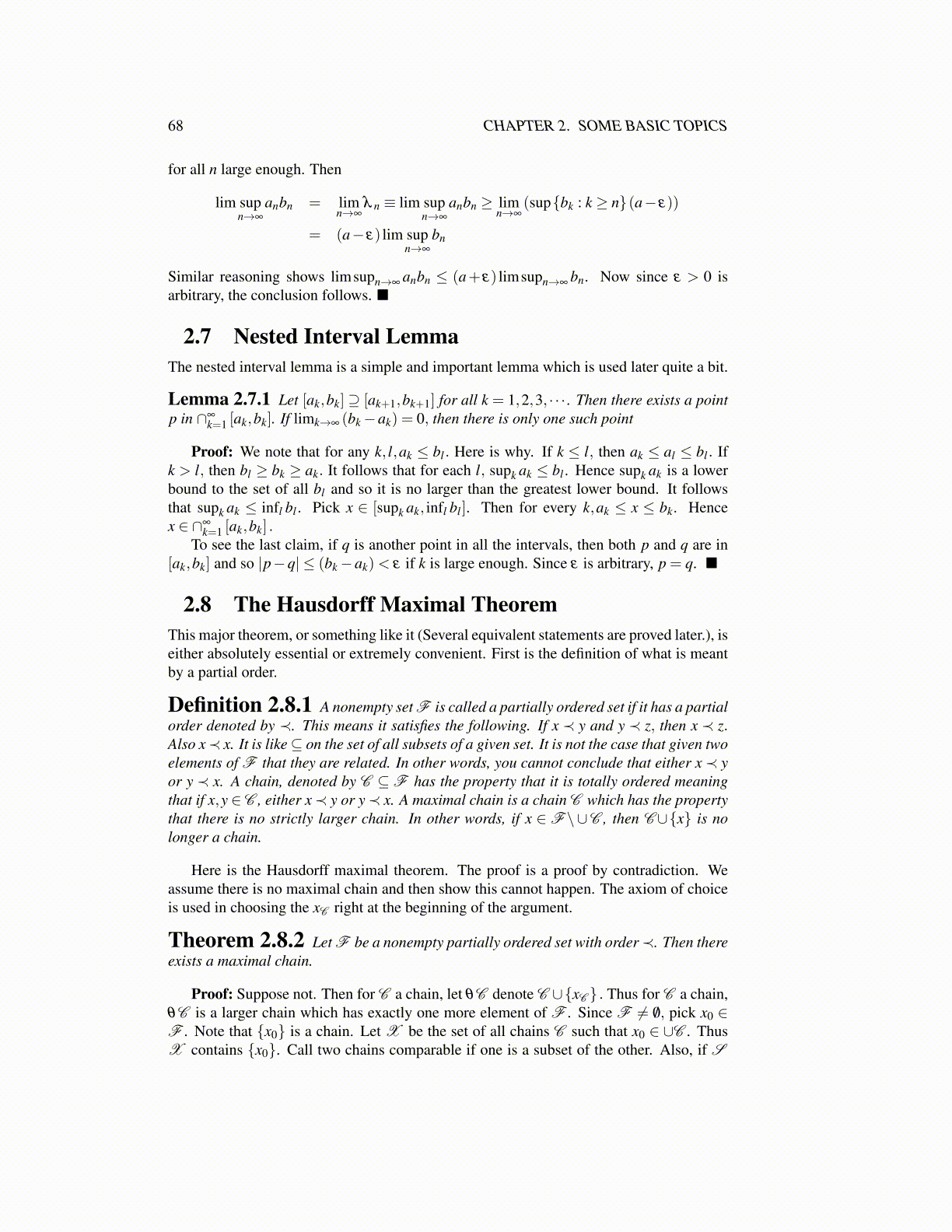
68 CHAPTER 2. SOME BASIC TOPICS
for all n large enough. Then
lim supn→∞
anbn = limn→∞
λ n ≡ lim supn→∞
anbn ≥ limn→∞
(sup{bk : k ≥ n}(a− ε))
= (a− ε) lim supn→∞
bn
Similar reasoning shows limsupn→∞ anbn ≤ (a+ ε) limsupn→∞ bn. Now since ε > 0 isarbitrary, the conclusion follows. ■
2.7 Nested Interval LemmaThe nested interval lemma is a simple and important lemma which is used later quite a bit.
Lemma 2.7.1 Let [ak,bk]⊇ [ak+1,bk+1] for all k = 1,2,3, · · · . Then there exists a pointp in ∩∞
k=1 [ak,bk]. If limk→∞ (bk−ak) = 0, then there is only one such point
Proof: We note that for any k, l,ak ≤ bl . Here is why. If k ≤ l, then ak ≤ al ≤ bl . Ifk > l, then bl ≥ bk ≥ ak. It follows that for each l, supk ak ≤ bl . Hence supk ak is a lowerbound to the set of all bl and so it is no larger than the greatest lower bound. It followsthat supk ak ≤ infl bl . Pick x ∈ [supk ak, infl bl ]. Then for every k,ak ≤ x ≤ bk. Hencex ∈ ∩∞
k=1 [ak,bk] .To see the last claim, if q is another point in all the intervals, then both p and q are in
[ak,bk] and so |p−q| ≤ (bk−ak)< ε if k is large enough. Since ε is arbitrary, p = q. ■
2.8 The Hausdorff Maximal TheoremThis major theorem, or something like it (Several equivalent statements are proved later.), iseither absolutely essential or extremely convenient. First is the definition of what is meantby a partial order.
Definition 2.8.1 A nonempty set F is called a partially ordered set if it has a partialorder denoted by ≺. This means it satisfies the following. If x ≺ y and y ≺ z, then x ≺ z.Also x≺ x. It is like⊆ on the set of all subsets of a given set. It is not the case that given twoelements of F that they are related. In other words, you cannot conclude that either x≺ yor y ≺ x. A chain, denoted by C ⊆F has the property that it is totally ordered meaningthat if x,y ∈ C , either x≺ y or y≺ x. A maximal chain is a chain C which has the propertythat there is no strictly larger chain. In other words, if x ∈ F\∪C , then C∪{x} is nolonger a chain.
Here is the Hausdorff maximal theorem. The proof is a proof by contradiction. Weassume there is no maximal chain and then show this cannot happen. The axiom of choiceis used in choosing the xC right at the beginning of the argument.
Theorem 2.8.2 Let F be a nonempty partially ordered set with order≺. Then thereexists a maximal chain.
Proof: Suppose not. Then for C a chain, let θC denote C ∪{xC } . Thus for C a chain,θC is a larger chain which has exactly one more element of F . Since F ̸= /0, pick x0 ∈F . Note that {x0} is a chain. Let X be the set of all chains C such that x0 ∈ ∪C . ThusX contains {x0}. Call two chains comparable if one is a subset of the other. Also, if S